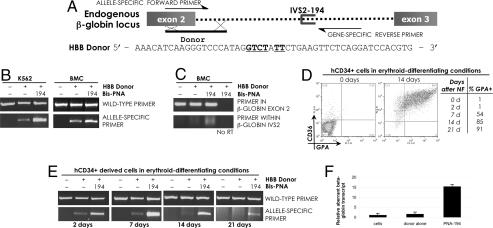Fig. 4.
PNA-stimulated modification of the endogenous beta-globin gene in human cells. (A) Schematic of bis-PNA-194 designed to bind within intron 2 of the endogenous beta-globin gene, and of a single-stranded HBB donor DNA molecule designed for modification of the beta-globin gene at the exon 2/intron 2 boundary. The modification is a 6 nt substitution (underlined) that introduces a splicing mutation in the beta-globin gene. The HBB donor DNA sequence corresponds to the template strand of the target site. (B) K562 cells synchronized in S phase, or beta-YAC BMCs, were transfected with bis-PNA-194 and HBB donor DNA. Genomic DNAs from the transfected cells were analyzed by allele-specific PCR to detect the presence of the sequence change introduced by HBB donor DNA. (C) RT-PCR of RNA harvested from transfected BMCs, using primers that flank the human beta-globin IVS2 region (Upper), or that anneal to the 5′ portion of the IVS2 region (Lower). Beta-YAC BMCs treated with bis-PNA-194 and HBB donor DNA show evidence of beta-globin transcripts that retain a portion of IVS2; such transcripts are absent in mock transfected BMCs. “No RT” indicates the lack of reverse transcriptase enzyme in the RT-PCR. (D) Human CD34+ cells were nucleofected (NF) with bis-PNA-194 and HBB donor DNA and then placed in erythroid-differentiating conditions for up to 21 days. Initially <2% of these NF cells were positive for CD36 or GPA; by 21 days postnucleofection, >90% of the nucleofected cells were GPA-positive. (E) Genomic DNAs from cells harvested at the indicated times posttransfection were analyzed by allele-specific PCR to detect the introduced modification in the beta-globin gene. (F) Analysis of RNA prepared from human CD34+-derived cells maintained and differentiated in culture 21 days after transfection of bis-PNA-194 and donor DNA. Quantitative RT-PCR using primers that anneal to the IVS2 sequence reveal the presence of an aberrant beta-globin transcript in the bis-PNA- and HBB donor DNA-treated cells. Aberrant transcript levels were normalized to total beta-globin transcript in all samples.

